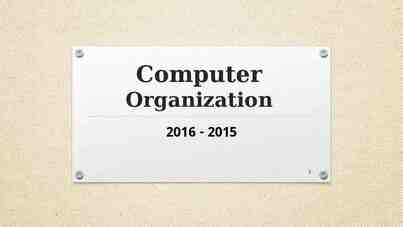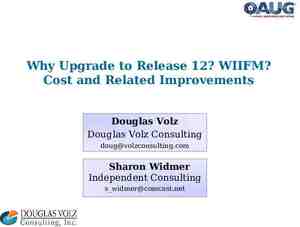Enterprise Reporting Introduction to Web Intelligence Enterprise
72 Slides4.40 MB
Enterprise Reporting Introduction to Web Intelligence Enterprise Reporting Services
Introductions Your name? Your agency? Any experience with Enterprise Reporting (ER) Financial Reports? How do you expect to use ER Web Intelligence? 2
Chapter 1 Overview 3
Course Objectives At the conclusion of class participants should have an understanding of the tool’s basic features: Logon View Reports Create New Documents Insert totals / subtotals Schedule Reports 4 Navigate Edit existing Documents Set Sections and Breaks Print / Export Reports
Training Materials Class Handouts – ER Intro to Web Intelligence (AFRS Financial Queries) training exercises – Course evaluation: please use this to note any issues or suggestions; this provides helpful feedback for improving future classes. Additional Resources – Toolbar Crosswalk – SAP Business Objects Web Intelligence Product Tutorials http://scn.sap.com/docs/DOC-7819 5
Web Intelligence vs. Standard Reports Standard Reports Pre-defined reports Report scheduling and viewing application 6 Web Intelligence Self service reporting For querying, organizing, and analyzing data
Hours of Operation ER Hours of Operation – 24/7 for viewing reports – Daily AFRS Data updates are from 8 pm through Midnight – New and existing AFRS queries cannot be generated during this time System Maintenance – Between 12:00 am and 7:30 am on the Last Monday of every month Getting Support – 8:00 a.m. to 5:00 p.m. Monday through Friday – 360-407-9100 – [email protected] 7
Chapter 2 Web Intelligence Access 8
Web Intelligence access Web Intelligence customers must have online access either through the State Governmental Network (SGN) or through Secure Access WA (SAW) for use from outside of the state firewall. This guide only includes information for access within the SGN. 9
Access through SGN Type https://reporting.des.wa.gov into the address bar of your internet browser and click Go, or press [Enter]. 1. Enter your assigned User Name in the User Name field 2. Enter your Password in the Password field. This application is using hardened password. Refer to the password guidelines on the next page. 3. Click the Log On button or press [Enter] to initiate a connection to the Web Intelligence. 10
Password Requirements The hardened password criteria are as follows: – Password must be at least eight characters long. – Password must contain at least two of the following character classes: upper case letters, lower case letters, numerals, and special characters. It cannot contain your logon ID. – Password must be changed every 120 days. – After five incorrect logon attempts, your user account will be locked. 11
Chapter 3 BI Launch Pad Navigation 12
BI Launch Pad Navigation The “Home” tab allows for quick access to: 1.Recently Viewed Reports 2.Unread Business Objects Inbox Items 3.Recently Run Reports 4.Unread Alerts (Currently not in use) 5.Applications 13
Folder Structure The “Documents” tab allows access to My Documents – Access to personal documents. Other users will not have access to these documents. Folders – Access to Agency and other public folders. Personal Categories – Allows users to group reports that are used frequently together regardless of their folder. Search – Allow users to search for documents and objects stored in Web Intelligence. 14
Viewing Existing Documents The BI Launch Pad allows for the viewing of existing Web Intelligence Reports. To view an existing Web Intelligence Report: 1. 2. Click on the report in the Recently Viewed or Recently Run lists on the “Home” tab or select the “Documents” tab. Select the correct folder where you need to view your report(s). In the example below we are looking in “My Documents” and “My Favorites”. 3. Right Click on the report you wish to view and from the menu select “View”. 15
Viewing Existing Documents 4. 5. 16 The report will open in view mode. To navigate you can scroll up and down or left and right, and advance pages using the page navigation controls located on the bottom of the page.
Chapter 4 Creating New Web Intelligence Documents 17
Creating New Web Intelligence Documents A Web Intelligence document consists of a query, a report and any formulas or variables created. The document can be very simple or very complex, depending on the user's business need at the time. The data is represented in Web Intelligence as a universe. A Universe provides an easy to use and understand data structure for non technical Web Intelligence users to run queries against a database to create reports and perform data analysis. You build queries using the universe objects. When the query is ran, the request is sent to the database, and the result is returned to the tool in a report, in the form of a table, consisting of columns and rows. 18
Creating New Web Intelligence Document 1. To create a new Web Intelligence document , click on the Web Intelligence Icon in the “My Applications” panel. 19
Creating New Web Intelligence Document 2. Click on "New" in the Web Intelligence Toolbar 20
Creating New Web Intelligence Document 3. Select Universe, and click OK. 21
Creating New Web Intelligence Document 4. Select a universe. If a default universe is proposed, you can use this universe or select a different universe. 5. Click Select 22
Creating New Web Intelligence Document Data Outline Panel – Shows the universe and its classes and objects that are available for reporting. 23
Creating New Web Intelligence Document A universe contains the following structures: Classes A class is a logical grouping of objects within a universe. It represents a category of objects. A class can be divided hierarchically into subclasses. Objects An object is a named component that maps to data or a derivation of data in the database. Types of objects – Dimension - Parameters for analysis. Dimensions typically relate to a hierarchy such as geography, product, or time. For example: Agency Code – Detail Provide a description of a dimension, but are not the focus for analysis. For example: Agency Title – Measure - Convey numeric information which is used to quantify a dimension object. For example: Amount 24
Creating New Web Intelligence Document Results Object Panel – Objects selected and placed here will be displayed in the report. 25
Creating New Web Intelligence Document Query Filter Panel – Where objects are added to define how to limit the data returned in a query. 26
Creating New Web Intelligence Document Select the objects you want to include in the query and drag them to the Result Objects pane. To add all the objects in the class, drag the class to the Result Objects pane. 27
Creating New Web Intelligence Document Repeat the previous step until the query contains all the objects you want to include. 28
Creating New Web Intelligence Document Select the objects on which you want to define query filters and drag them to the Query Filters pane. 29
Creating New Web Intelligence Document After a data element is selected, a filter editor box will display as illustrated below. The default operator is "In list". Click on the arrow by In list to view the complete list of operators. Choose Equal to from the list of operators. Type the value in the text box on the filter editor box. 30
Creating New Web Intelligence Document Repeat the previous step until the query contains all the filters you want to include. 31
Creating New Web Intelligence Document To remove an object from the Result Objects or Query Filters panes, click Remove at the top right corner of the pane. To remove all objects from the Result Objects or Query Filters panes, click Remove All at the top right corner of the pane. 32
Creating New Web Intelligence Document Click Run Query to run the query. 33
Navigating the Report Panel After a query is run, the results will be displayed in the Report View window. 34
Save a Web Intelligence Document After a query is run, the results will be displayed in the Report View window. Depending on your security profile, you can save a document to either a personal or a public folder within the tool. If you are a regular user, you can save a file to a folder under My Folders. If you are a power user, you can save to either a folder in My Folders or to certain Public Folders. 35
Save a Web Intelligence Document 1. To save a Web Intelligence Document click the Save button on the upper left corner. 36
Save a Web Intelligence Document 2. The following Save Document dialog box will appear. 3. Enter the Title for the Document and click Save on the bottom. Document title can only contain numbers and letters; it cannot contain special characters. Note: The My Favorites folder is highlighted so that is the default location where the document or query will be saved. You can choose another folder to which you have access, if you wish. 37
Chapter 5 Query Filter Options 38
Operators 39 Operator Retrieves Data Example Equal To Equal to the specified value {Fiscal Month} Equal To 10 retrieves data for fiscal month 10 Not Equal To Not equal to the specified value {Fiscal Month} Not Equal To 10 retrieves data for all fiscal months other than 10 Greater Than Greater than the specified value {Fiscal Month} Greater Than 10 retrieves data for fiscal months 11 and higher Greater Than or Equal To Greater than or equal to the specified value {Fiscal Month} Greater Than or Equal To 10 retrieves data for fiscal months 10 and higher Less Than Lower than the specified value {Fiscal Month} Less Than 10 retrieves data for fiscal months 01 through 09 Less Than or Equal To Lower than or equal to the specified value {Fiscal Month} Less Than or Equal To 10 retrieves data for fiscal months 01 through 10 Between Between two values; including these values {GL Account} Between 6500 and 6600 retrieves data for GL Accounts 6500 through 6600 Not Between Outside the range of two specified values {GL Account} Between 6500 and 6600 retrieves data for all GL Accounts not between 6500 and 6600
Operators 40 Operator Retrieves Data Example In List Same as values specified {Agency} In List ‘225;310;477’ retrieves data only for Agencies 225, 310, and 477 Not In List Everything other than values specified {Agency} Not In List ‘225;310;477’ retrieves data for all excluding Agencies 225, 310, and 477 Is Null Which there is no value entered in the database Is Null does not apply to the AFRS Universes Is Not Null For which there is a value Is Not Null does not apply to the AFRS Universes Matches Pattern Includes a specific string that is like a value {Program Index} Matches Pattern ‘15%’ retrieves data for any Program Index that begins with 15 Different From Pattern Excludes a specific string that is like a value {Program Index} Different From Pattern ‘15%’ retrieves data for any Program Index that does not begin with 15 Both Corresponds to two specific values {Budget Option} Both “1” and “2” retrieves data for budget options one and two Except Corresponds to one specified value and does not correspond to another specified value {Budget Option} Except Option “1” retrieves data for budget options other than one
Modify a Document 1. Locate your query in your [My Favorites] folder 2. Right click 3. Select “Modify” 41
Modify a Document 4. Select the Data Access tab and click the Edit icon located on the Data Providers sub tab. 42
Between To set a filter using a range of values use the "Between" operator. Since you have placed Fiscal Month in the Result Objects you can drag down to the Query Filter Box. Change the operator to Between from the drop down list of operators. 43
Between The filter editor box now displays two fields for entering values. Enter a value in each box. The ‘Between’ operator is inclusive and will include the values entered. 44
Values from list To set a filter using a list of values use the default operator "In list". Click on the arrow on the end of the filter editor box. Select Values from List. 45
Values from list Select the values from the list. Multiple items can be selected by holding the ‘CTRL’ or ‘Shift’ keys and selecting your values. Once the values are selected, use the top arrow to move the values into the ‘Selected Value(s)’ box. Then click OK. 46
Values from list When free forming a list of values each value should be separated with a semicolon and no spaces. Examples: 6510;6410;6505;6560 47
Matches Pattern To include wildcard characters in a value to further define a filter use Matches Pattern. This is very useful when you are trying to find data that begins with, ends with, or contains a specified value. For example, you may create a filter to find all vendors that start with a certain word. Please note that using text in filters is not case sensitive. 48
Matches Pattern 1. Drag a dimension into the Query Filters area. 2. Change the operator to Matches pattern by selecting it from the drop-down list of operator values. 49
Matches Pattern 3. Type your value into the Value entry field followed by a ‘%’. This will select values that begin with the value entered followed by any other characters. 50
Chapter 6 Working with Web Intelligence Reports 51
Simple Calculations – Sum 1. Highlight the data in the Amount column 2. Select the Analysis tab and click the Sum icon located on the Functions sub tab. 3. Navigate to the end of the report to see your total 52
Format Numbers To reformat the numbers in a measure column select the Format tab and choose the format from the dropdown list located on the Numbers sub tab. 53
Remove Columns To Remove a column – 1. Click and drag the object into the Available Objects Window. 54
Remove Columns 2. Select Remove Column in the Remove dialogue box and click OK. 55
Add Columns To add Column – Click and drag the object to the report table where it needs to be added. Overlap it with the edge of the cell next to it. Drop the object in the desired spot. 56
Add / Remove Columns When adding and removing columns the data will aggregate based on the columns displayed in the report. 57
Breaks A break divides a large table into smaller sub-tables based on a selected dimension value. Using a break, you can display subtotals by the specified value, as well as a grand total for all values. The data is automatically sorted in ascending order by the dimension values when a break is inserted. To add a break, click in the data to highlight the column. Click on the Insert/Remove Break button on the Reporting toolbar. 58
Chapter 7 Printing and Exporting Reports 59
Printing Reports Reports can be printed by clicking on the Print icon located on the File tab. 60
Printing Reports When the Print icon clicked the Print dialogue box displays. Set the print options and click OK. 61
Exporting Reports 1. To export a report click on the dropdown arrow next to the Save icon and select Save as. 62
Exporting Reports 2. When Save as is clicked the Save dialogue box displays. Select My Desktop, My Documents, or My Computer as the location. 63
Exporting Reports 3. Verify the file name and update if needed. 4. Select the file type. 64
Exporting Reports 5. Click Save. 65
Scheduling Reports Web Intelligence reports can be scheduled to run on a recurring schedule. 1. On the Documents tab, locate and select the object that you want to schedule. 2. Right click 3. Select “Schedule” 66
Scheduling Reports 4. The schedule Dialogue will open. 67
Scheduling Reports 4. In the Instance Title box, type a name for the instance. 5. In the "Schedule" dialog box, click Recurrence 6. Choose one of the recurrence options from the Run object list and set the required options. When you click Schedule, the default is “immediately.” The following additional options are available: Once This option requires a start and end time parameter. The object runs once at the time that you specify. If you schedule the object with events, the object will run once if the event is triggered between the start and end times. Hourly This option requires information in hours and/or minutes for how frequently the object is run. Instances are created regularly to match the parameters that you enter. The first instance is created at the start time that you specify, and the object will cease to run on its hourly schedule at the end time that you specify. Daily This option requires a start and end time parameter. The object runs once every N days at the time that you specify. It will not be run after the end time that you specify. 68
Scheduling Reports Weekly This option requires a start and end time parameter. Each week, the object runs on the selected days at the time that you specify. It will not be run after the end time that you specify. Monthly This option requires a start date and time, along with a recurrence interval in months. The object runs on the specified date and time every N months. It will not be run after the end time that you specify. Nth Day of Month This option requires a day of the month on which the object is run. Instances are created regularly each month on the day that you enter at the start time that you specify. The object will not be run after the end time that you specify. 1st Monday of Month This option requires a start and end time parameter. An instance is created on the first Monday of each month at the time that you specify. The object will not be run after the end time that you specify. Last Day of Month This option requires a start and end time parameter. An instance is created on the last day of each month at the time that you specify. The object will not be run after the end time that you specify. X Day of Nth Week of the Month This option requires a start and end time parameter. An instance is created monthly on a day of a week that you specify. The object will not be run after the end time that you specify. Calendar This option allows you to select a calendar of dates. (Calendars are customized lists of schedule dates that are created by the Bi platform administrator.) An instance is created on each day that is indicated in the calendar, beginning at the start time that you specify and continuing until the end time that you specify. 69
Scheduling Reports 7. 8. 9. Click Formats Select the format you want to schedule to from the Output Format list. Click Destinations a) b) c) Select a destination option Select the Keep an instance in the history check box if you want to save a copy of the instance. Select the Use default settings check box if you want to the report to be sent to the logged in user. You can schedule to the following destination locations: Default Enterprise Location If you select this option, the instance is saved within Business Objects. BI Inbox This option saves the instance to BI Inboxes specified. Email This option sends the instance to the specified email recipients. FTP Server This option saves the instance to the specified FTP server. File System This option saves the instance to the specified file location. 10. Click Schedule 70
Log Off To log off click the Log Off button. 71
Questions Questions 72













































































